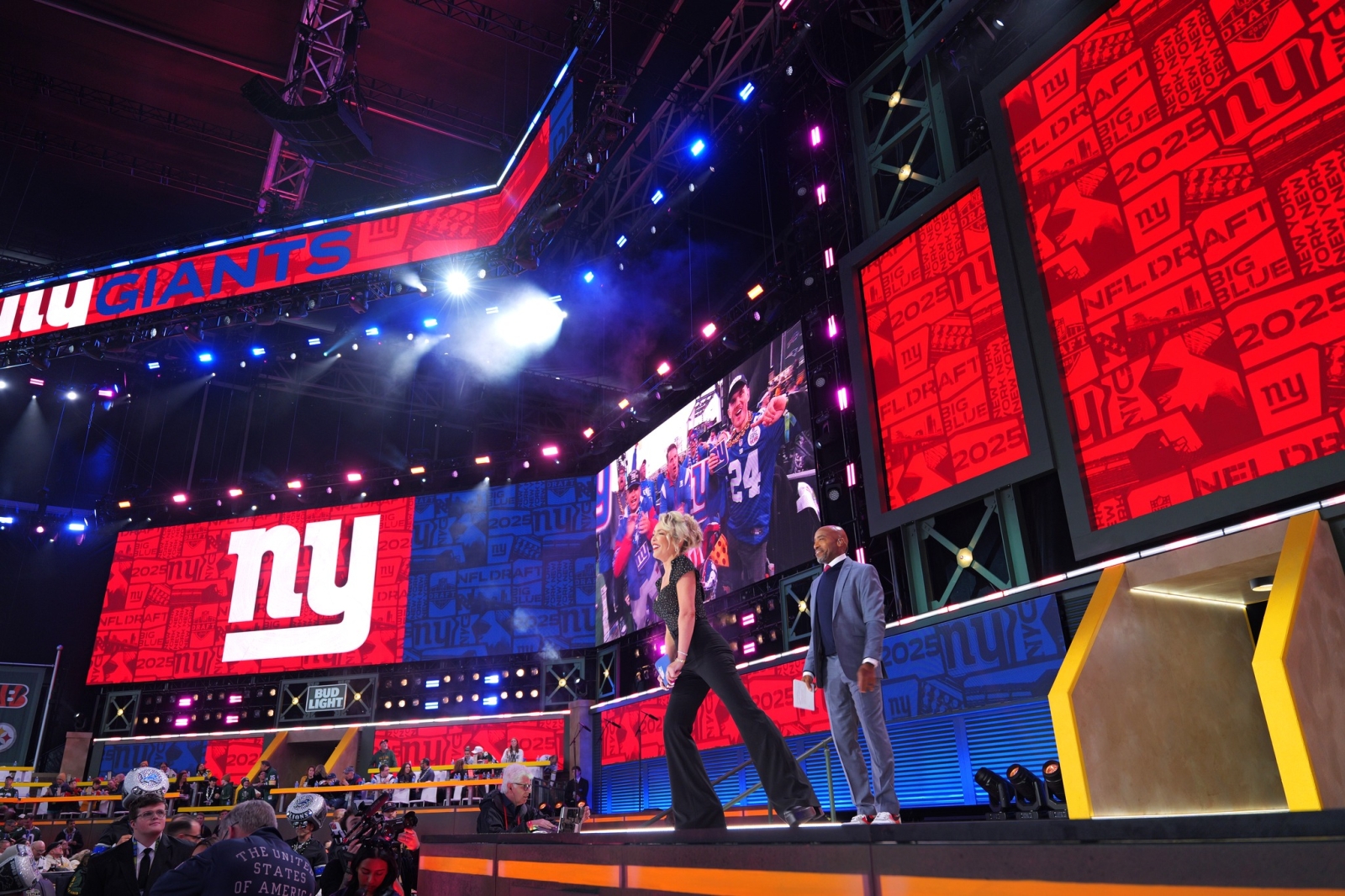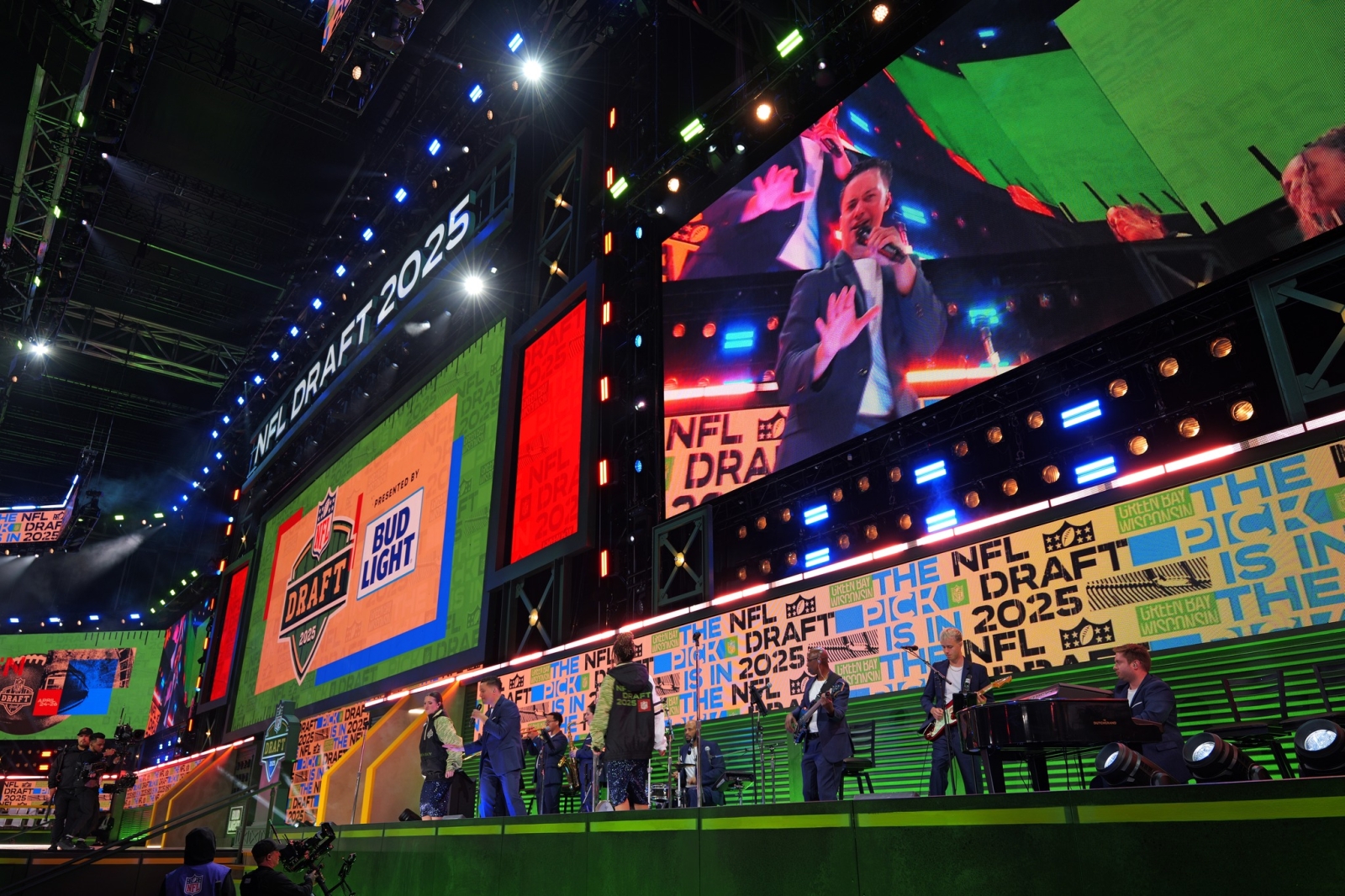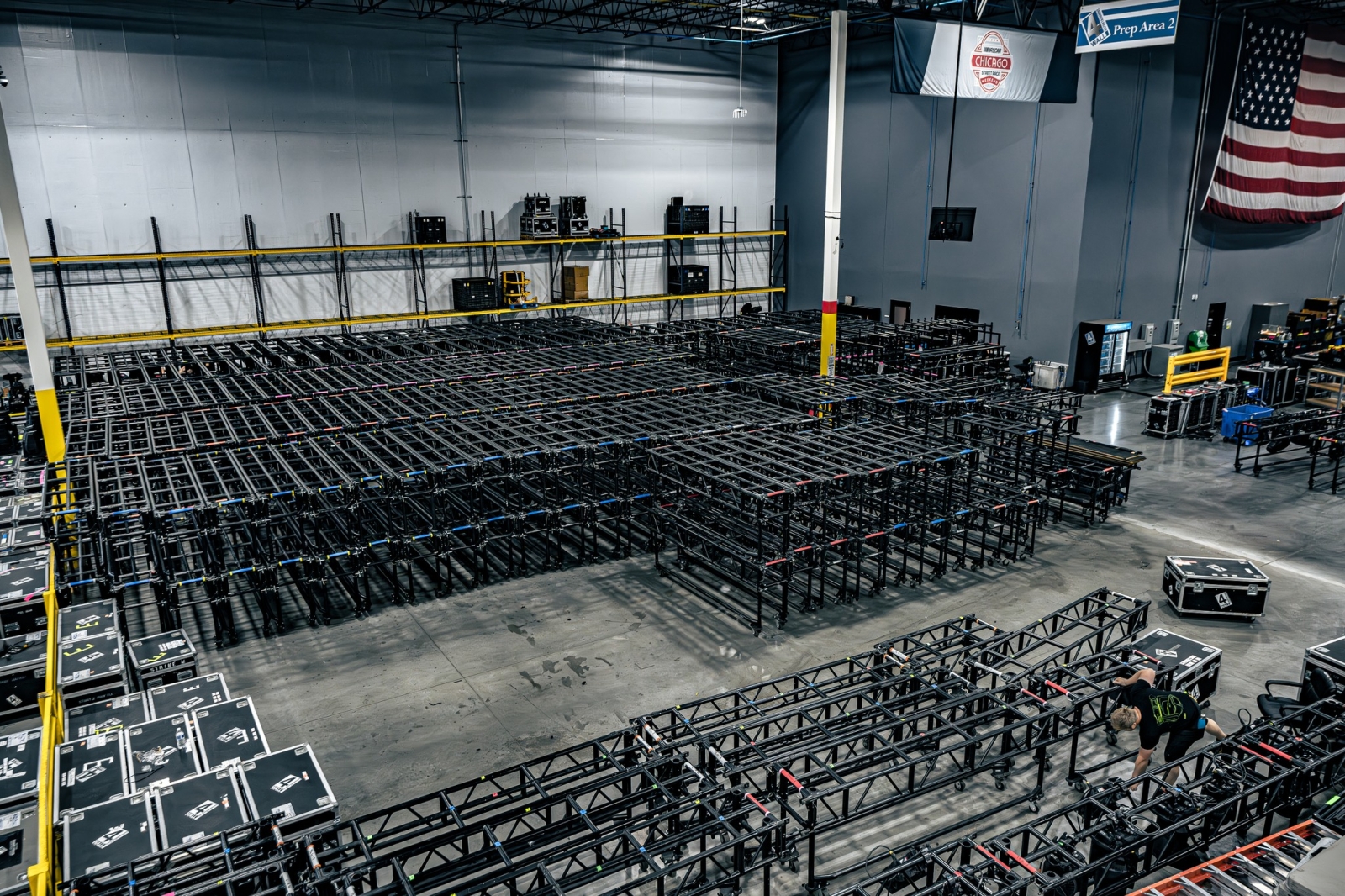4Wall In The News
NFL Draft 2025

4Wall provided C3 Presents with gear and services for the 2025 NFL Draft. This article was originally posted on PSLN.com and can be found here.
The 2025 NFL Draft was held in Green Bay, WI in the shadow of the iconic Lambeau Field, home of the NFL's Green Bay Packers. The NFL Draft has become a massive event on the NFL's yearly calendar and the production has kept growing to match the fan enthusiasm for the event.
Back supporting the NFL Draft was production vendor, 4Wall Entertainment who supplied the lighting and LED video to realize the visual design of Lighting Designer Jon Kusner of 22 Degrees, and Scenic Designer Kris Bast of C3 Presents. Not only did the design team have to support the huge main stage, known as the NFL Draft Theater, but also the massive Green Room where the broadcast could highlight the prospective players. They also lit the tunnel that players walked through to get to the stage when their name was announced as a team's pick.
The massive footprint of the stage included a huge roof structure with lights surrounding the gigantic video screens that displayed all the information for both the broadcast cameras, and the many thousands of fans in attendance. By the numbers, the gear count is extraordinary: over 3,200 lighting fixtures; 1,279 LED panels; 70 miles of cable (1,029 football field lengths); 3 miles of truss (45 football field lengths); and 856,323 lbs. (428 tons) of total gear.
Large-Scale Design
"Having the opportunity to work on this show since 2018, it creates a shorthand of knowing the priorities, and how to stream-line it. We know what has worked in the past," says Kusner. "It's a similar process each year, and there's something comforting about that because it's a humongous show in scale. The biggest moment of the event is the first pick, which comes down to the Commissioner walking on stage in the theater and announcing, 'the first pick of 2025 is...' and calling the prospect's name. Suddenly, that young man just won the lotto, and he has a long walk from the Green Room to the theater stage itself. For the rest of his career, that player will have the video of that moment played anytime they do a career highlight for him; cutting to the moment he was picked first in the Draft. Once he finds his way to the stage, he shakes hands and hugs the Commissioner, and that moment is over. We then rinse and repeat for the rest of the Draft."
While it is broadcast, the NFL Draft is handled more as a live in-person production than a pure TV show. As the NFL continues to nurture its fans the draft has become a massive event hosted in various NFL team cities drawing a huge fan following. "I'd say that the population of Green Bay doubled at least for the couple of days of the draft," notes Kusner. The NFL used the nearby Resch Complex's Expo center for the draft prospect's Green Room and to accommodate the more than 600 media members on site. The Green Room was a massive project on its own, in terms of gear needed to light everywhere in the vast space. "The Draft has quietly grown in scale, and it's completely underappreciated in the amount of gear that ends up in there," comments Kusner. "The challenge of the Green Room is, it's a cavernous rectangle and we have to be ready to shoot people walking in any direction to make their way to the stage. So, it ends up with a big blanket of soft light, which makes it forgiving for coverage, but then Kris has dressed out the space, so we have to light the scenery, banners, walls, plants, rugs, and furniture. It's one of the funny things as a lighting designer, where people look around and comment on there being a lot of equipment in the Green Room. Well, when you're standing in a building the size of a Home Depot, and they want it to look nice...Wanting all of that to look good takes a lot of work by everyone and a lot of lights."

Extending the LED Screens
While the NFL Draft Theater has a massive amount of LED video screens used as scenery, it's a challenge that Kusner, who has dealt with similar on broadcast award shows, takes in stride. He understands how to balance that when lighting the stage for both a broadcast capture and for the audience on site. "I feel like on almost any award show, that the video footprint has become the scenery of the show," he explains, "so I have to figure out how to get along with that in a way the celebrates the scenery. I always feel that you have to light people first, then light the scenery second, and then light the environment third. If I look at those three pieces of importance, deciding what the screens are doing-and how to get along with them-is one of my top responsibilities. We tend to pick a lot of gear that's almost an extension of the LED screens, so we're getting along with the screen content to make it feel like one, big, happy environment." In terms of gear that can act as 'an extension of the LED screens', Kusner has a key gear choice he relies on these days. "We had a lot of the [ACME] Pixel Lines. That's just a very visually appealing light," says the designer. "It allows for an extension of the screen in an easy way."
One of the concepts that Scenic Designer Bast came up with was a homage to Lambeau's stadium lights, which Kusner then created for the Draft. "The visual story that was the basis for his set was the idea of Lambeau Field and its iconic green trusses that hold up its stadium lights; capturing the iconic feeling of that visual," describes Kusner. "He had the idea of the vintage Maxi Brute lighting fixture to be a nod to that stadium light look, since we were right next to Lambeau. This is where lighting becomes scenery, an extension to the scenery. Unfortunately, Maxi Brutes have been dumped by so many shops, they're a rare- and expensive-animal, and the lamps are even harder to get. So, we went with a large number of ETC's Source Four PARs, because of their reputation, and the large quantity available that they could be that reflection of Lambeau Field's lights.

Vendor Support
To realize the massive design Kusner was pleased to again be working with 4Wall on the event. "This was the second year working with Robby Kurtz (VP of Business Devolpment), RJ Thomas (Director of Live Events) and Doug Hallman (Project Manager) of 4Wall," notes Kusner, "and they have this show completely figured out. Plus, they have a good relationship with C3 Presents. I think that 4Wall went way above and beyond what was required in terms of supporting this production. They learned last year that this is a big and difficult show. Not only is it a lot of gear, but there are high expectations of how to handle the load-in and how it's all managed on site. They know that not only were they hired to provide the gear, but to treat it as a complete turnkey project to get the show done. Robby and Gabe [Thruston], the 4Wall Project Manager, brought a big crew into the shop to help get it pulled and prepped alongside about seven of the production staff. It took a huge amount of manpower to get this all organized. All the gear was pre-rigged, like a tour, so it was all ready to deploy when it got on site. It was already to go for Gaffer Cole Kiracofe when it arrived. It's bonkers to think about the amount of gear that went in, in a very short time, including having to deal with weather pauses and other delays."
Team Lighting
As Kusner noted projects of this scale take a team, and that was no different for 22 Degrees. Kusner had several people supporting him on Team Lighting. "Madigan Stehly was my Associate Lighting Designer on the Theater side, and did all the drafting for everything," states Kusner. "He should get a gold medal for all that, because he became kind of the drawing organizer, interdepartmentally. There was a lot of information to manage in terms of the drawings. Then Jeff Behm was a Lighting Director, who while mostly in the Green Room, bounced between all the locations for the project. I'd say he spent most of his time in the tunnel. Not only did Jeff focus and run the Green Room, but he ran the console at times during load-in when we needed to ring something out."
Kusner continues, "I only had one programmer, Brian Jenkins, who had the task of managing this massive system between the three locations of the Theater, the tunnel, and the Green Room, and make it all play back simultaneously. Then I also had Cole Kiracofe as Gaffer, Jason Uchita was Lighting Crew Chief, who became the head of paperwork for all data and power, and John Cox who was the Best Boy and spent the most time in the ditches keeping the whole system going. It's a mind-numbing amount of information those three had to keep organized."
In the end, the 2025 NFL Draft, while full of pick drama, came off without a production hitch. The broadcast audience got a great show, as did the thousands of die-hard football fans in attendance. The hard work of all and thoughtful design meant that the draft picks had a comfortable-and well-lit-Green Room, an energizing tunnel walk and a sense of the scale of the moment when they stepped on to the big stage.

Vendor View
4Wall Entertainment
Robby Kurtz, VP Business Development
On the solutions 4Wall provided:
4Wall's scope was to provide lighting, LED screens, and rigging for the NFL Draft Theater, the Green Room and the tunnel to the stage, and everything around those spaces. The NFL Draft Theater structure was bigger than last year, so that area needed more of everything to fill it, and the Green Room was a huge project all by itself. The key to this project started with having good people, having a great crew. Also having killer project managers internally that dealt with all the LED video, as well as the massive lighting package. On site, we had seven days from when full production load-in started to our handoff to the NFL. We also had three days of pre-rig time, so we brought the riggers into the shop to work in the structure prior to the load-in. A week prior, we sent crew up to put spanner trusses in the roof while it was down to get the points in between where we needed them. We prepped all the equipment like a tour, so it was all pre-rigged to roll in and be able to go right up. The lighting and rigging were prepped in our Nashville shop, and all the LED came out of our Lititz, PA location.
With so much LED video, there was a need to be as lightweight as possible, as well as having three different resolutions. They wanted a very high-res product for the hero wall, and weight was a concern. We used ROE Carbon C3one, which incorporates ROE's carbon fiber technology, making it an ultra-lightweight product. Then we had ROE CB5 and CB8 for other screens around the stage. We were using indoor LED products outside. The roof gave us some protection, but with the wind issues, we were kept an eye on managing them all safely.
In terms of lighting the Green Room in the convention center behind the Draft Theater, it was essentially its own large corporate show's worth of equipment. The original spec was for all standard 12" truss for the lighting positions in the Green Room. We swapped the 12" truss to all Tyler Truss Systems GT Truss, so everything could be pre-rigged and prepped in the shop. Then everything could roll right in and deploy in place. We had over 500 sticks of 10' GT Truss just for the Green Room. Even the ARRI SkyPanels rode in the GT Truss. There was a lot of lighting needed in that space so they could shoot in any direction.
For the 'stadium lights' throughout that Kris had designed, we had about 400 [ETC] Source Four PARs, and every one of them had to be single circuited. We had a lot of Socapex to power them all up. It's been a long time since I used a Source Four PAR; it was old school, but it was the best solution as far as cost-effectiveness. Those were used around the Green Room, as well as used in the Theater built into the wings left and right, as well as in some parts of the tunnel. One of the biggest challenges we dealt with on this show was the weather; the wind was a constant factor. We just had to keep on top of making things safe and making sure as we were working, that the order we were working in made sense with everyone else working on the project. The big thing was we were always trying to beat the weather.

On supporting the design and production team:
Jon Kusner, Madigan Stehly, and their lighting team are always great to work with. They just know how to do this kind of gig. They've been doing this show for some time, as well as many large scale shows like this, so they understand what they're trying to achieve, and how it will read on camera. We also liked working to support Kris Bast and the team from C3 Presents. Kris' scenic design looked great, especially when they were going for the look of Lambeau Field, tying that into the stage of the Draft Theater. It looked incredible. There are always issues around lighting, video, and scenic when all are working in the same tight quarters. We worked hard with production to make sure that things went up in the right order because they are so layered, and it's so tight, if one of your elements is out of order, it's going to be very hard to build the LED wall. Then of course, working with Sean Worlow, and his team from The Production Collective is always a pleasure. Sean has great people on his team that we work with on other projects as well. When we get together on site, it's just friends getting together to do a show.
On why 4Wall was the right vendor:
I'd say that 4Wall was the right vendor for the NFL Draft because of our long relationship with C3 Presents, who manages the overall project. They do a lot of festival work, and this show is run much like a festival-an environment that 4Wall works in really well. We understand the moving parts and pieces and how it all comes together. We really know how to navigate all those things. Then also having close working relationships with Sean, Jon, and the rest of the team. We already knew how to navigate the process going into it. Another piece of this project was having so much depth of inventory of IP65 rated gear for this gig to handle the weather issues. Really though it is the 4Wall team that makes us the right vendor. We couldn't have done the NFL Draft without the amazing crews we had-all the lighting, LED, and rigging crews that we had on site, the prep crews in the various 4Wall shops, as well as all the people managing at 4Wall that were really helping make sure all the details came together.
